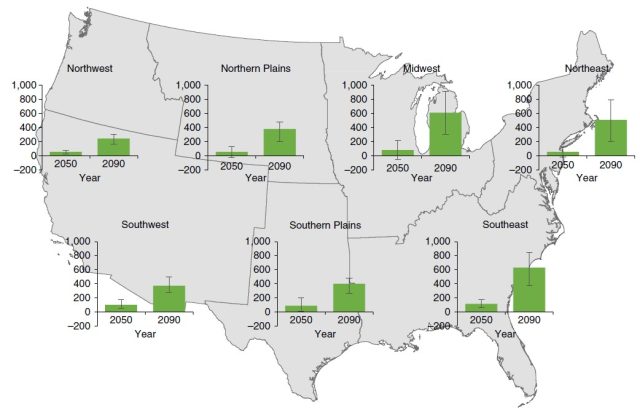Despite what the worlds least-interesting talking gecko would have you believe, no one likes handing over payments for car insurance. But theres one thing everyone likes even less: suddenly paying for expensive repairs not covered by your insurance.
Similarly, opponents of action on climate change like to complain about the costs of eliminating fossil fuel emissions. Typically, this implies that the alternative—ignoring climate change—is free. It is not.
A new study by Jeremy Martinich and Allison Crimmins of the US Environmental Protection Agency provides the most detailed estimate yet of the economic costs of climate change in the United States. They found that taking action to reduce emissions could save us at least $200 billion per year by the end of the century.
The effort involves the use of models to simulate the ways different economic sectors are affected by climate change and how those effects ripple from one sector into others. A notable 2016 study used past relationships between temperature and economic activity to project the impact of warming on six economic sectors in the US, drilling down to the county level. This new study tries to expand that to 22 sectors and relies less on mathematical relationships from the past to project to the new climates of the future.
The 22 sectors include fisheries, electrical generation, coastal property, roads, harmful algal blooms, air quality, and others. Each was analyzed with the results of five different climate models simulating two scenarios: a high-greenhouse-gas-emissions “business-as-usual” scenario that warms the world around 4.5°C (8°F) by the end of this century and an intermediate emissions scenario that results in about 2.5°C warming (4.5°F).
Everything was analyzed for the lower 48 states, while details on Alaska, Hawaii, and Puerto Rico were limited.
The model results show that either greenhouse gas emissions scenario would be costly. In the high-emissions scenario, the calculated economic damages added up to about $500 billion per year by 2090. That is due to things like lost labor and premature deaths caused by changes in temperature extremes and air pollution, loss of infrastructure damaged by flooding, and even recreation and tourism losses from disappearing coral reefs, declining snowpack, and harmful algal blooms.
The researchers describe these estimates as conservative, given that a limited set of impacts are included. “For example,” they write, “the wildfire analysis captures only suppression costs, and does not estimate health impacts from degraded air or water quality, property damage, or timber loss.”
As in previous studies, there are large differences between the damages in different regions of the US. The impact of extremely hot weather, flooding, and West Nile virus, for example, are significantly greater in southern states. The loss of tourism revenue as coral reefs disappear is obviously a bit more relevant in Hawaii than Oklahoma. And coastal property is more threatened in low-lying Florida than in Alaska, where geologic activity is raising land elevations along the coast.
But there are enough factors included here that problems in one region tend to be balanced by different impacts in others. If you compare per-person impacts, the regions actually come out pretty close.

By comparing the estimated damages in the lower and higher emissions scenarios, you can see the economic value of actions that cut emissions. The difference between the two scenarios, in this case, is a cool $220 billion per year by 2090 for the US as a whole. Thats how much economic damage is avoided by steering toward one future rather than the other—even in the low emissions scenario, there are still $280 billion per year in damages Read More – Source
[contf] [contfnew] 
Ars Technica
[contfnewc] [contfnewc]







